A genus of about 30 – 55 species of small deciduous trees or shrubs in the family Rosaceae found in Europe and Asia, including eating apples and cooking apples. The other species are commonly known as crab apples and wild apples.
Crab Apples are one of the best flowering trees for use as bonsai. Malus consists of about 35 species of which 3 are commonly used for bonsai-
- Malus sylvestris - Common Crab Apple has leaves to 5cm long, pink-flushed white flowers in Spring followed by greenish-yellow/red fruit to 2cm across.
- Malus cerasifera - Nagasaki Crab Apple is the variety most often used as bonsai because of its prolific white flowers that are pink in bud. These then an abundant display of red fruit in the autumn
- Malus halliana - Halls Crab Apple has pink flowers, glossy green foliage with small purple fruits that can be rather sparse.
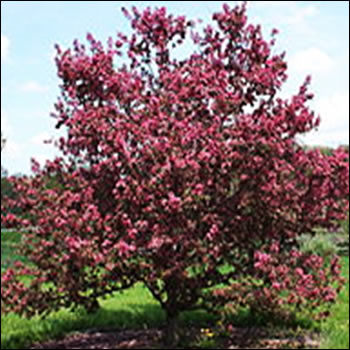
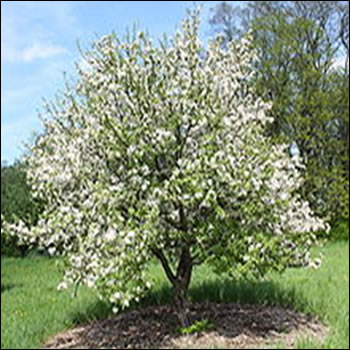
Typically they are 4 – 12m tall with a dense, twiggy crown. The leaves are 3 – 10 cm long, alternate, simple, with a serrated margin.

The flowers are borne in corymbs, and have five petals, which may be white, pink or red and are perfect, with usually red stamens that produce copious pollen and a half-inferior ovary; flowering occurs in the spring.
Domestic apples, either eating or cooking varieties can equally be grown as bonsai, but it rarely happens except for novelty value. There is a certain absurd disproportion between a large apple on a tiny tree.

Many varieties of apples require cross-pollination if they are to bear fruit between individuals by insects (typically bees, which freely visit the flowers for both nectar and pollen); these trees are self-sterile and therefore self-pollination is impossible, making pollinating insects essential.
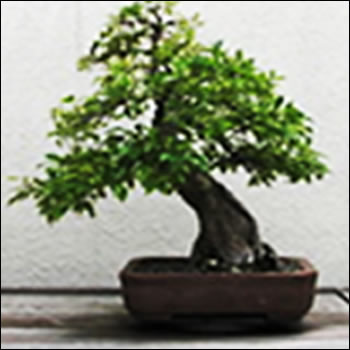

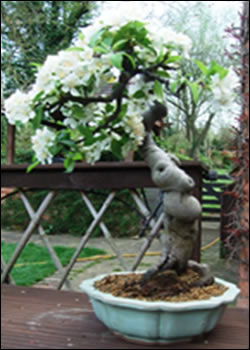
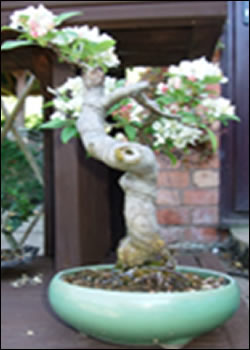

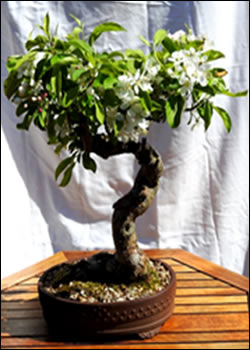
Flowers in spring, late March to early April
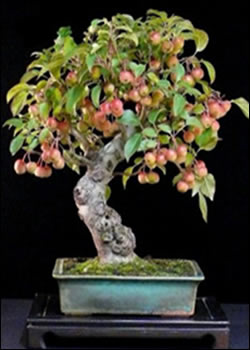

Ripened fruit in late summer
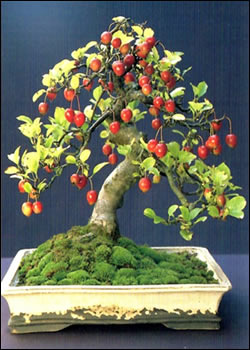
Growing Malus as bonsai
Position:
Crab Apples prefer to be in partial shade in moist, well-drained soil and provide good air circulation to discourage mildew problems. Crab Apples are very hardy; however, if placed in a shallow pot they may need some frost protection.
Watering:
Give plenty of water especially when fruiting. The crab apple needs a lot of water during the growing season and must not dry out, especially when it flowers or produces fruit. Fruits will be dropped if sufficient water is not provided.
Feeding:
Feed fortnightly until flowering. If you feed after flowering and before fruits set you may cause leaf growth at the expense of fruiting. If trees are in training and vigorous growth is required at the expense of fruit, continue to feed fortnightly, otherwise cease feeding until fruit are well developed. Allow one year in three to go without fruiting to improve the vigour of the tree.
Pruning:
- Prune in early spring for new shoots, back to one or two leaves.
- Trees should then be left unpruned until late summer. Pruning must be undertaken by late August, otherwise vegetative growth is more likely to occur than flower buds for next year.
- Trees in training that require maximum growth can be left unpruned until autumn.
- If fruit are not required, dead-head flowers as they go over.
- If the tree produces a great number of fruit, remove all but one from each cluster in order not to weaken the tree.
- Do not feed between flowering and fruit setting. Use low nitrogen feed once you are sure the fruit has set and is developing.
Wiring:
Younger branches and twigs can be wired but older ones are quite brittle and you are better positioning them using guy wires.
Repotting:
Young crab apple trees should be repotted annually in spring, older ones every two or three years. When the trees get weaker it is important to repot and prune the roots. As the apple bonsai tree needs a lot of water and nutrients, choose a slightly larger pot and use a soil mix which can retain enough water but is still well-draining.
Unfortunately the crab apple, is attacked by a wide range of pests and diseases. Aphids, scale, mealybugs and caterpillars can be removed manually and / or controlled with insecticide. Red spider mites require an insecticide containing Caricide. If mildew or rust occurs, a special fungicide is needed.
Apple canker is a disease caused by a fungus, Neonectria ditissima, which attacks the bark of apples and some other trees, causing a sunken area of dead bark and eventually, death of the branch. New cankers form from mid-spring, and once formed are present all year. Infections often begin at wounds or buds.

